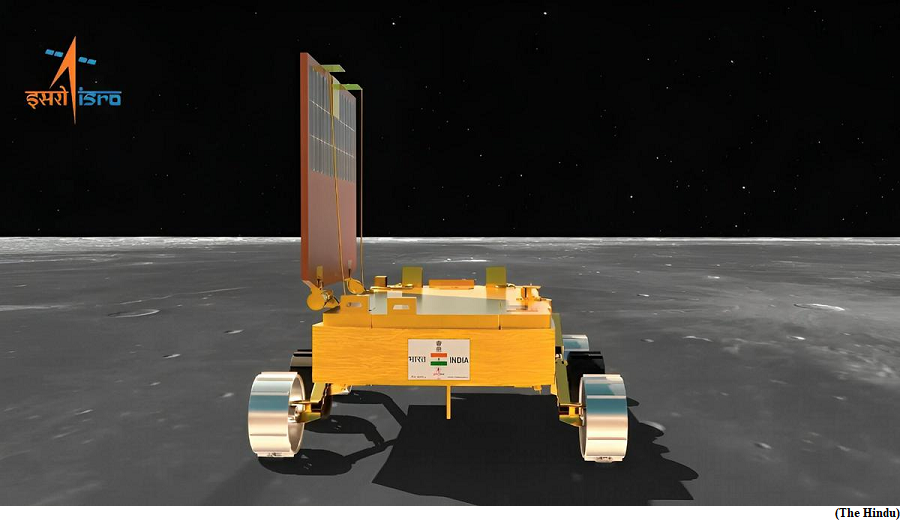Pragyan confirms Sulphur near South Pole of Moon (GS Paper 3, Science and Technology)

Why in news?
- Pragyan, the rover of the Chandrayaan-3 mission, has confirmed the presence of sulphur on the moon’s surface, near its south pole, and is still searching for hydrogen.
LIBS instrument:
- The Laser-Induced Breakdown Spectroscopy (LIBS) instrument aboard the rover has made the first-ever in-situ measurements on the elemental composition of the lunar surface near the South Pole.
How it works?
- The LIBS is a scientific technique that analyses the composition of materials by exposing them to intense laser pulses.
- A high-energy laser pulse is focused onto the surface of a material, such as a rock or soil, and generates localised plasma.
- The collected plasma light is spectrally resolved and detected by charge coupled devices. Since each element emits a characteristic set of wavelengths of light when in a plasma state, the elemental composition of the material can be determined.
New Findings:
- Preliminary analyses have unveiled the presence of Aluminum (Al), Sulphur (S), Calcium (Ca), Iron (Fe), Chromium (Cr), and Titanium (Ti) on the lunar surface.
- Further measurements have revealed the presence of manganese (Mn), silicon (Si), and oxygen (O). Thorough investigation regarding the presence of Hydrogen is under way.
National Space Day:
- The Union Cabinet adopted a resolution hailing the Chandrayaan-3 mission, saying it is a victory not just for the ISRO but also a symbol of India’s progress and ascent on the global stage.
- It welcomed that August 23 would be celebrated as National Space Day.
Cyclone frequency may rise over Indian coast from the warming of Pacific, study
(GS Paper 1, Geography)
Why in news?
- As per a recent study; Pacific Decadal Oscillation (PDO) could make tropical cyclones more frequent in the coming years.

Details:
- Tropical cyclones that originate near the Equator, while being devastating, have been unusually subdued in recent decades.
- The last major cyclone of this kind in India was Cyclone Okchi, which devastated parts of Kerala, Tamil Nadu and Sri Lanka in 2017.
- However, a combination of global warming and a cyclical event called the Pacific Decadal Oscillation (PDO) that repeats every 20 to 30 years, could make such cyclones more frequent in the coming years.
- The number of such equatorial-origin cyclones was 43% less in the period from 1981 to 2010 compared with 1951 to 1980, and this was because the PDO was in a ‘warmer’ or positive phase.
ENSO phenomenon:
- A warming of the Central Equatorial Pacific, called an El Nino, often corresponds to reduced rainfall over India whereas cooler-than-normal temperatures, or a La Nina, is linked to excessive rainfall.
- This pattern, collectively called the El Nino Southern Oscillation (ENSO) phenomenon, repeats in the Pacific over two to seven years.
Impact of PDO:
- However, the PDO is not an annual occurrence and, on an average, corresponds to a warmer than average Western Pacific Ocean and relatively cooler Eastern Pacific, though this plays out over much longer time scales.
- However, unlike an ENSO, a ‘positive’ or ‘warmer phase’ of a PDO can be known only after several years of measuring ocean temperatures and their interaction with the atmosphere.
- In 2019, the PDO entered a cooler, negative phase and if it remains so, could mean more tropical cyclones in the post-monsoon months that originate near the equator.
Current scenario:
- An El Nino is developing in the Pacific, the effects of which are manifested in central and southern India, which have recorded rainfall deficits of 7% and 17%, respectively.
World’s first prototype of the BS 6 Stage II ‘Electrified Flex fuel vehicle’ launched
(GS Paper 3, Science and Technology)
Why in news?
- Recently, the Union Minister for Petroleum & Natural Gas unveiled the Prototype of World’s 1st BS-6 Stage-II, Electrified Flex fuel vehicle, developed by Toyota Kirloskar Motor.

Key Highlights:
- This initiative by Toyota is particularly important as it introduces the world’s first BS 6 (Stage II) Electrified Flex Fuel vehicle prototype, which has both the flex fuel engine as well as an electric powertrain, thereby offering higher use of ethanol combined with better fuel efficiencies.
- It is based on the Innova Hycross and is engineered to adhere to India’s stricter emission standards, marking it as the first-ever BS 6 (Stage II) Electrified Flex Fuel Vehicle prototype globally.
- The forthcoming stages for this prototype encompasses meticulous refinement, homologation, and certification processes.
Electrified Flex Fuel Vehicle:
- India has huge Ethanol potential, much beyond E20 mix. This excess potential can be utilised by the country by promoting Flex Fuel vehicle (FFVs) and Flex Fuel Strong Hybrid Electric Vehicle (FFV-SHEV) / Electrified Flex Fuel Vehicle.
- An Electrified Flex Fuel Vehicle has both a Flexi Fuel engine and an electric powertrain. This gives it ability to provide dual benefit of higher ethanol use and much higher fuel efficiency as is in case of a Strong Hybrid Electric Vehicle (SHEV), which can provide 30-50% higher Fuel Efficiency as it can run 40-60% in EV mode with engine shut off.
- As Electrified Flex Fuel Vehicle uses minimal advanced chemistry batteries, it also guards against possible Geo-political risks of battery raw material supplies.




